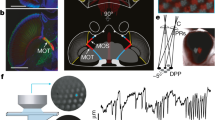Summary
The well known optomotor yaw torque response in flies is part of a 3-dimensional system. Optomotor responses around the longitudinal and transversal body axes (roll and pitch) with strinkingly similar properties to the optomotor yaw response are described here forDrosophila melanogaster. Stimulated by visual motion from a striped drum rotating around an axis aligned with the measuring axis, a fly responds with torque of the same polarity as that of the rotation of the pattern. In this stimulus situation the optomotor responses for yaw, pitch and roll torque have about the same amplitudes and dynamic properties (Fig. 2). Pronounced negative responses are measured with periodic gratings of low pattern wavelengths due to geometrical interference (Fig. 3). The responses depend upon the contrast frequency rather than the angular velocity of the pattern (Fig. 4). Like the optomotor yaw response, roll and pitch responses can be elicited by small field motion in most parts of the visual field; only for motion below and behind the fly roll and pitch responses have low sensitivity.
The mutantoptomotor-blind H31 (omb H31) in which the giant neurones of the lobula plate are missing or severely reduced, is impaired in all 3 optomotor torque responses (Fig. 5) whereas other visual responses like the optomotor lift/thrust response and the landing response (elicited by horizontal front-to-back motion) are not affected (Heisenberg et al. 1978).
We propose that the lobula plate giant neurons mediate optomotor torque responses and that the VS-cells in particular are involved in roll and pitch but not in lift/thrust control. This hypothesis accommodates various electrophysiological and anatomical observations about these neurons in large flies.
Similar content being viewed by others
Abbreviations
- EMD :
-
elementary movement detector
References
Blondeau J (1977) Electrically evoked motor activity in the fly (Calliphora erythrocephala). Doctoral thesis, Eberhard Karls-Universität, Tübingen, FRG
Braitenberg V (1972) Periodic structures and structural gradients in the visual ganglia of the fly. In: Wehner R (ed) Information processing in the visual system of Arthropods. Springer, Berlin Heidelberg New York, pp 3–15
Buchner E (1976) Elementary movement detectors in an insect visual system. Biol Cybern 24:85–101
Buchner E, Götz KG, Straub C (1978) Elementary detectors for vertical movement in the visual system ofDrosophila. Biol Cybern 31:235–242
Dvorak DR, Bishop LG, Eckert HE (1975) On the identification of movement detectors in the fly optic lobe. J Comp Physiol 100:5–23
Eckert H (1979) Anatomie, Elektrophysiologie und funktionelle Bedeutung bewegungssensitiver Neurone in der Sehbahn von Dipteren (Phaenicia). Habilitationsschrift, Ruhr-Universität Bochum, FRG
Eckert H, Bishop LG (1978) Anatomical and physiological properties of the vertical cells in the third optic ganglion ofPhaenicia sericata (Diptera, Calliphoridae). J Comp Physiol 126:57–86
Faust R, Buddenbrock W von (1951) Die Regulierung des Gleichgewichtes der höheren Dipteren durch die Halteren. Experientia 7:265–266
Fischbach K-F, Heisenberg M (1981) Structural brain mutant ofDrosophila melanogaster with reduced cell number in the medulla cortex and normal optomotor yaw response. Proc Natl Acad Sci USA 78 (in press)
Goodman LJ (1965) The role of certain optomotor reactions in regulating stability in the rolling plane during flight in the desert locustSchistocerca gregaria. J Exp Biol 42:385–407
Götz KG (1963) Movement discrimination in insects. In: Reichardt W (ed) Processing of optical data by organisms and by machines, Rendiconti SIF, Course XLIII. Academic Press, London New York, pp 494–509
Götz KG (1964) Optomotorische Untersuchung des visuellen Systems einiger Augenmutanten der FruchtfliegeDrosophila. Kybernetik 2:77–92
Götz KG (1968) Flight control inDrosophila by visual perception of motion. Kybernetik 4:199–208
Götz KG (1975) The optomotor equilibrium ofDrosophila navigation system. J Comp Physiol 99:187–210
Götz KF, Wenking H (1973) Visual control of locomotion in the walking fruitflyDrosophila. J Comp Physiol 85:235–266
Götz KG, Hengstenberg B, Biesinger R (1979) Optomotor control of wing beat and body posture inDrosophila. Biol Cybern 35:101–112
Hausen K (1976a) Functional characterization and anatomical identification of motion sensitive neurons in the lobula plate of the blowflyCalliphora erythrocephala. Z Naturforsch 31c:629–633
Hausen K (1976b) Struktur, Funktion und Konnektivität bewegungsempfindlicher Interneurone im dritten optischen Neuropil der SchmeißfliegeCalliphora erythrocephala. Doctoral thesis, Eberhard-Karls-Universität, Tübingen, FRG
Hausen K (1981) Monocular and binocular computation of motion in the lobula plate of the fly. Verh Dtsch Zool Ges 1981:49–70
Heisenberg M (1972) Behavioral diagnostics; a way to analyse visual mutants ofDrosophila. In: Wehner R (ed) Information processing in the visual system of Arthropods. Springer, Berlin Heidelberg New York, pp 265–268
Heisenberg M, Buchner E (1977) The role of retinula cell types in visual behavior ofDrosophila melanogaster. J Comp Physiol 117:127–162
Heisenberg M, Götz KG (1975) The use of mutations for the partial degradation of vision inDrosophila melanogaster. J Comp Physiol 98:217–241
Heisenberg M, Wolf R (1979) On the fine structure of yaw torque in visual flight orientation ofDrosophila melanogaster. J Comp Physiol 130:113–130
Heisenberg M, Wonneberger R, Wolf R (1978) Optomotor-blindH31 — a Drosophila mutant of the lobula plate giant neurons. J Comp Physiol 124:287–296
Hengstenberg R (1977) Spike responses of “non-spiking” visual interneurones. Nature 270:338–340
Hengstenberg R, Hengstenberg B (1980) Intracellular staining of insect neurons with Procion Yellow. In: Strausfeld NJ, Miller TA (eds) Neuroanatomical techniques. Insect nervous system. Springer, Berlin Heidelberg New York, pp 308–325
Pierantoni R (1976) A look into the cock-pit of the fly. The architecture of the lobula plate. Cell Tissue Res 171:101–122
Reichardt W (1961) Autocorrelation, a principle for the evaluation of sensory information by the central nervous system. In: Rosenblith WA (ed) Sensory communication. MIT Press, Cambridge, MA, pp 303–317
Srinivasan MV (1977) A visually-evoked roll response in the housefly. Open-loop and closed-loop studies. J Comp Physiol 119:1–14
Strausfeld NJ (1976) Atlas of an insect brain. Springer, Berlin Heidelberg New York
Thorson J (1966) Small signal analysis of a visual reflex in the locust. Kybernetik 3:41–66
Author information
Authors and Affiliations
Rights and permissions
About this article
Cite this article
Blondeau, J., Heisenberg, M. The three-dimensional optomotor torque system ofDrosophila melanogaster . J. Comp. Physiol. 145, 321–329 (1982). https://doi.org/10.1007/BF00619336
Accepted:
Issue Date:
DOI: https://doi.org/10.1007/BF00619336




